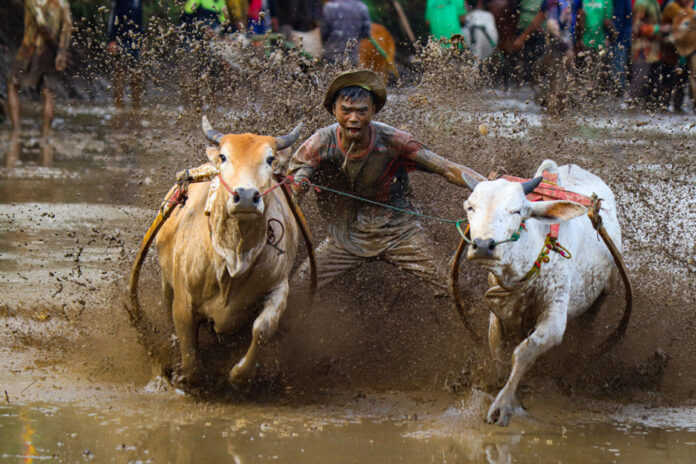(Sumatra, Indonesia) We were beginning to lose hope. My wife Pascale, incidentally co-pilot par excellence, told me that we had crossed the end of the route on Google Maps. We had been looking for the place by scooter for almost two hours, through the fields, the forest, the mountains and the rice paddies of this region of West Sumatra.
Will we eventually find that pacu jawi, an event we’ve been told so much about since arriving on this Indonesian island? Pronounced “pachu djawi”, the term literally means “running of the bulls”, and we would really like to see these reckless men hanging on to their tails, with their feet on a piece of wood, and running completely haphazardly through the mud.
We stop alongside farmers we meet. “Pacujawi?” we ask, pointing in one direction or the other as a question mark. We finally come across good Samaritans who are going to the same place. We follow them. And a few minutes later, no doubt, we are there. Hundreds of mopeds are parked. Their owners are a hundred yards away, enjoying the show.
We make our way through the crowd, for crowd there is, even so far from the nearest village, even in such a remote corner of Indonesia. We put our heads between those of the attentive spectators, and finally, we see them go, a few meters below.
Two bulls. A wooden hitch hung around their necks. A jockey at the back, one foot on each of the pieces of wood at the end of the hitch. And his hands around the tails of the two beasts. They are even seen biting said tails during the race, in an attempt to control and direct them. When the animals leave, watch out. It goes quickly. It’s dangerous. It splashes. And it is spectacular.
The track is approximately 200m in length and 30m in width, according to our estimates. It consists essentially of a lake of mud, hollow about 30 cm. The participants are covered in it, because most of the time, they fall and end up submerged. Then start again.
And the danger is very real: we saw a jockey fall from his makeshift carriage, then be trampled by two beasts on the loose, with no one to control them. The crowd held its breath. Participants came to his rescue, lifting him by his arms and legs to bring him to safety, before other beasts left the starting point (the teams of jockeys do not always manage to hold them back). In the chaos of the day, we did not know what happened to the man trampled by bulls scurrying at high speed.
But why, you tell me? And I hear you. We asked ourselves the same question. We ask ourselves again. Especially since there is no real competition in pacu jawi. No winner or loser. At best, a jockey can expect to sell his bulls at a high price if they perform well.
But otherwise, quite simply, the idea is to combine the useful with the pleasant, passing through the absurd.
Historically, it took place twice a year, after the harvest. Each throw of the bulls allows you to plow the land (your great-great-grandfather, he has… my apologies). There is also a protrusion at the bottom of the wooden confection on which the jockey places his feet, which causes the ground to rotate. Of course, the presence of dozens of these animals – and the resulting dung – will also help fertilize these lands for the next few months.
Over time, the pacu jawi has grown in popularity. With the help of the tourist office, it now takes place on a weekly basis. The places where he stands vary from week to week – hence the murky directions we left with that morning. The event even gained international exposure when photographs illustrating the race were awarded prizes, notably at the 2013 World Press Photo. I might have been able to submit a worthy successor to this photo if I had managed to capture the competitor who had his cigarette in his mouth during his race, causing hilarity and probably a hint of admiration among the spectators. It will be for next time.
For a good part of the afternoon, we watch cows having their tails bitten in the mud, we suddenly recoil when they get too close, we wander in the nearby food market, we listen to the traditional music played not far away, and we had ourselves photographed by Indonesians happy to receive such a visit – they are all extremely kind. We finally decide to leave, hoping to find a more direct route than on the way there. We therefore follow the procession of motorcycles leaving the site at the same time.
In a few minutes you are on the main road. Note to self: Never follow Google Maps again.















